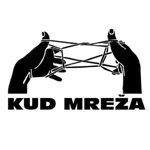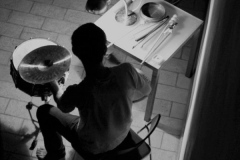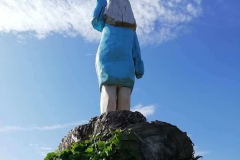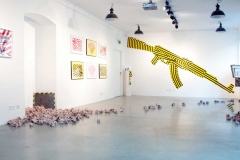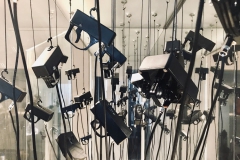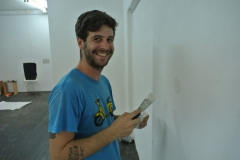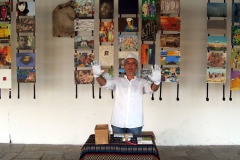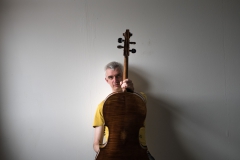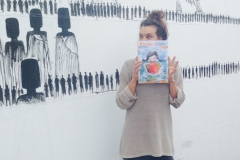François Donato: “The way we perceive sounds in space, is particularly meaningful to the listener”
– Your one-month stay in Ljubljana was densely filled and busy with various projects and collaborations with local art organizations. What experience did you gather working in Slovenia during these last four weeks?
François Donato: “We had a very good time in Ljubljana, working hard but also enjoying the city and the kindness and welcome of people, especially the organizers’. It was cool to share some moments, in a very simple and friendly atmosphere. We had a very good support from the Lighting Gverila and KUD Mreža teams to organize both technical and artistic aspects of our installation and performance. Moreover, working and living at Metelkova was a good experience because it is an inspiring place at several levels: the creative people working there, the singularity of the place itself, all the events taking place in the different venues and also the diversity of the people visiting the place.”
– Your audio-visual performance ElectroAnima Experiment with visual artist Golnaz Behrouznia at Kino Šiška was one of the most spectacular shows I have ever witnessed. What is the conceptual idea behind the performance? How the audio and visual elements interconnected and responded to each other conceptually and technically?
François Donato: “The initial project of the performance has been conceived by Golnaz Behrouznia as a journey in the history of the living. It was in summer 2017 after we worked together on Lumina Fiction #2, the interactive installation. So basically, the main concept is to explore different steps and evolutions of the matter from the initial light emerging from the void to the complex organizations of living organic creatures. We worked out the concept together and tried to embody its different aspects firstly in a scenario giving its structure to the performance and then in the visual and sound domains, each of us producing respectively specific elements for the sequences. We wanted also to create a real link during the performance between us, not only because of the complicity playing together, but a physical link that could produce concrete interactions between images and sounds based on our gestures and the on the fly choices we make improvising together. So our respective computers are connected with an audio channel that we decide to open and modulate depending on the sequences of the performance. It produces specific effects on the images and represents a third dimension in the project. But there is also a kind of distance between images and sounds. We seek mainly a synchronization between us to follow the planned scenario but each of our media deals with time in its own way. That means that some sound structure or musical intention for example has to emerge, evolve and disappear in a specific time and it is the same with the visual. Each nourishes the other but keeps a relative independence. Of course, we have some very precise marks that trigger changes for both of us. But we did not want to write a completely fixed piece. The way Golnaz plays the video sequences, the effects she applies change each time we play and the same for me with sounds.”
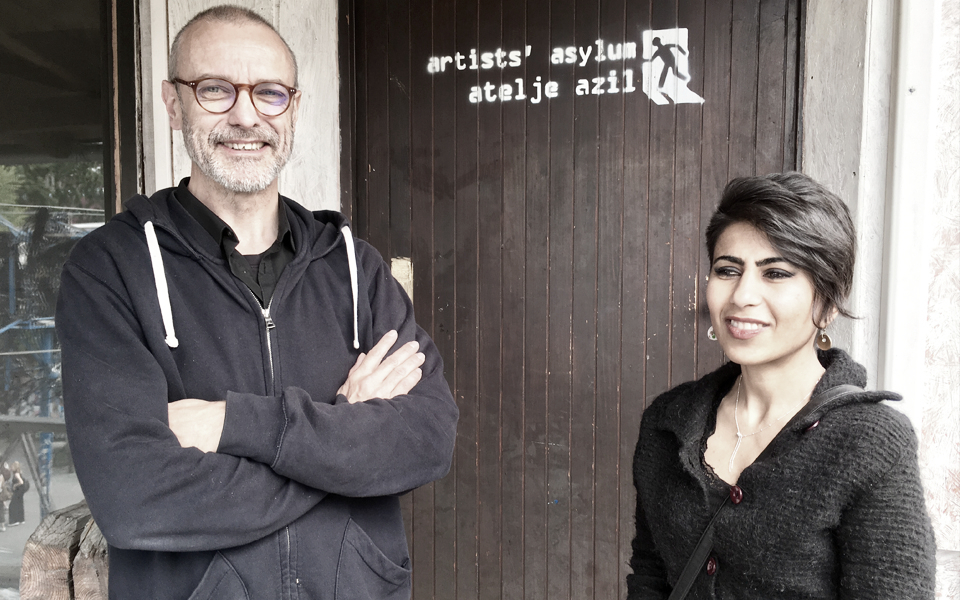
François Donato and Golnaz Behrouznia in front of Studio Asylum. “We wanted to create a real link during the performance between us, not only because of the complicity playing together, but a physical link that could produce concrete interactions between images and sounds based on our gestures and the on the fly choices we make improvising together.” Photo: Nataša Serec
– In the second part of your performance at Kino Šiška you presented audio works by five contemporary composers. What methods and criteria did you use for the selection, realization and presentation of these compositions?
François Donato: “Well, when I initiated this project in Ljubljana, it was clear for me that it has to be linked in a way or another to the local scene. It was not a question of coming with our performance and installation and that is it. Because I have a very good friend of mine living here, Marina Žlender, who is a talented music critic and knows very well what is going on artistically speaking in the city. I made very good contact with Mauricio Valdés San Emeterio, a Mexican composer and guitarist living also in Ljubljana. We had several talks the three of us as I came two times in February and November in 2018, exchanging ideas and putting names on the table. I wanted to setup an acousmatic concert and I wanted also to have women composers in the program, so I finally chose Bojana Šaljič and Nina Dragičević plus of course a piece by Mauricio. I wanted also to present a French composer, a close friend with whom I’ve worked on different projects, and who is an expert in multi-channel composition, Hervé Birolini. On the musical level, it was important for me to present different aesthetic approaches. I didn’t want a specific theme for the concert, but mainly emphasize the diversity of acousmatic music production at an international level. It was the case also about the spacial dimension of the pieces. Hervé’s piece and mine are 5.1 pieces written for a typical surround system, the one by Bojana is a four-channel piece. Those ones imply mainly to adapt the distribution of the channels to the way speakers are disposed in the venue and then to ‘follow’, to accompany the global balance doing some slight tweaks on the levels of the different channels. Mauricio’s and Nina’s are stereo pieces which allow a more versatile approach of space in the venue, because it is possible to choose in real time, following the structure of the music, between several combinations of speakers: fronts, sides, rears and all the mixes possible between them.”
– Bojana Šaljič and Nina Dragičević are among the most remarkable Slovenian composers. How did you come across their works? Did they propose which particular compositions of theirs got to be performed, or you chose specific works by them?
François Donato: “As I said, it was on the advices of Marina Žlender and Mauricio Valdés San Emeterio that I contacted Bojana and Nina. I explained to them the global project and just proposed them to participate with an acousmatic piece of theirs. I had previously listen some tracks available on the internet as I did not know any of their works before. I was really happy to discover their respective production and present them to the audience. They propose to me to choose between several pieces and in addition to the musical interest of each, I also respected a length criteria in order to have a balanced program. As it was not possible to invite them to play their piece on the acousmonium we setup in the venue, I played myself with a big pleasure.”
– Acousmatic concerts are known from the mid-fifties, primarily connected to musique concrète, but they are still rare to experience in Slovenia – especially as opposed to the regular live performance format. What are the most ideal conditions for an acousmatic music presentation?
François Donato: “This is a very difficult question, because precisely it is not a regular format. And I would say that this is not a single format, but a variety of possible formats. Basically, the principle is to put several speakers around the audience, a bit like in a movie venue for surround soundtracks of the films. So depending on the number of speakers you can use, you may have a simple 8 independent channels system as we used for the concert at Kino Šiška (like two fronts left-right, one center front, two sides left-right and two rears left-right plus a subwoofer for low frequencies) or a very complex one with 64 speakers, mainly independent channels, disposed around, above and under the audience if the venue allows it. Of course you may not use all the channels for one piece but make specific choices to emphasize the music you have to play on specific speakers disposed in specific areas of the venue. The way we perceive sounds in space is particularly meaningful to the listener of such a concert, even if he or she is not aware of that. Spacial information in the sound perception are crucial to help us to understand our surroundings. At a primary level, the reptilian brain as it is called, it helps to determine if there is a danger coming and adapt our behavior consequently. On an artistic and thus more sophisticated level, it produces hierarchical relationships between sound elements because even if human hearing system can perceive sounds at 360°, the position and shape of our ears, plus the acoustic disturbances produced by the head itself, imply a better reception of sources coming from front than sources coming from one side or from the rear. So ideally, a good sound system for acousmatic music would be a system with a number of speakers that covers quite well the space around the audience with good technical specs associated to a mixing desk, either analog or digital, that offers a single independent output for each speaker or group of speakers. Venue with no fixed seats are great also because you can organize the speakers disposal exactly as you want. There are several venues in the world that are specialized in complex multi-channel rendering. It started historically with the sound system designed and used by Iannis Xenakis at the Brussels World Exhibition in 1958. Karlheinz Stockhausen also has been a pioneer in that field among others with the sphere of speakers he used at the Osaka World Exhibition in 1970. But the very beginning of real time sound spatialization standed in 1951 for a concert of the just born musique concrète.”
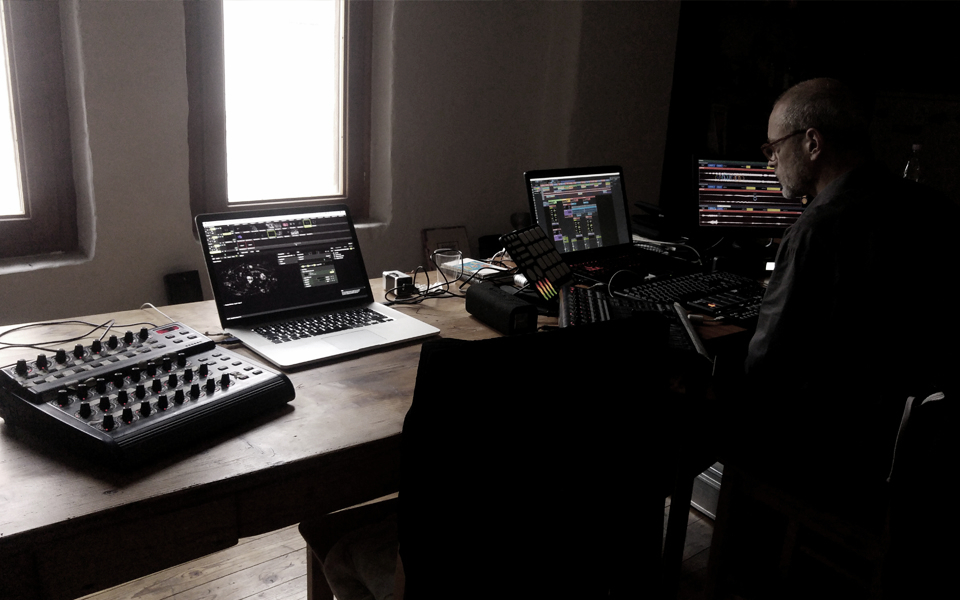
François Donato: “I was welcome at GRM studios for a professional training on digital sound, and they kept me 16 years. I was a studio assistant at the beginning, helping invited composers to deal with studio technologies and to realize their works.” Photo: Golnaz Behrouznia
– GRM (Groupe de Recherches Musicales) brought many things to music, from musique concrète to acousmatic music, and you are closely connected to the legendary French studio and research institution. How did you get involved in their activity, and what parts you took in the organization’s work?
François Donato: “I discovered musique concrète during my chaotic musical studies in the eighties and it was obvious for me that it was the direction I had to follow. Then I was focused on learning and practicing more and more to improve my skills. At that time a production studio was very expensive, because tape machine, mixing desk and good speakers were expensive. So it was only a few places where it was possible to work. And also you know that France is a very centralized country and as a young artist living in the South-West of France, a pleasant region to chill and enjoy life but a dead-end at that time for experimental arts, I wanted to settle in Paris to be nourished by the intense artistic life going on there. So I fixed to myself a simple goal: moving to Paris and create links with the GRM in any way. It finally happened one year later when I won a composition prize with jury ruled by the GRM director at that time, François Bayle. I was then welcome at GRM studios for a professional training on digital sound, and they kept me 16 years. I was a studio assistant at the beginning, helping invited composers to deal with studio technologies and to realize their works. It was really informative for me, more than classes at conservatory. And with the evolution of the GRM itself, I became responsible of the global music production, managing studio works and events organization with other assistants. I finally quit in 2005, because I wanted to live other experiences with other people in another place and I moved to Toulouse. And met Golnaz Behrouznia there three years later.”
– We cannot end this talk without asking you: how did you find your stay at KUD Mreža’s Studio Asylum? The always vibrant environment of Metelkova with all its venues, galleries, organizations, artists, activists, visitors and tourists can provide a stimulating and highly inspiring creative environment, but staying here also requires a certain measure of patience. To put it simply: do you recommend Studio Asylum to artists who are working with sound?
François Donato: “Totally. As I said at the beginning of this talk, it was a vivid stay we had at Metelkova. Hope to come back sometime for another project. The issue with working as a sound artist is to be able to have a quiet place from time to time in order to listen carefully what we are working on with good speakers. But we can work efficiently with headphones. And by the way, the place is mainly noisy during evenings because of the concerts and parties in the venues around. But the two rooms flat is quite well isolated and it’s fine to go downstairs for a break and enjoy the lively atmosphere of Metelkova. So, a message for KUD Mreža team: I have an idea for a new multi-channel composition that may interest you, so do you think…?”
Afternoon event at Studio Asylum: Seijiro Muraya percussion solo
Percussionist Seijiro Murayama was born in 1957 in Nagasaki, Japan. He started performing improvised music in 1972, under some influence of Vinko Globokar and musicologist Fumio Koizumi. A relocation to Paris in 1999 led to fruitful collaborations that extended into contemporary dance, theatre and performance as well as ongoing partnerships with musicians Michel Doneda, Jean-Luc Guionnet, Éric Cordier, Lionel Marchetti and Mattin – among many others. After over a decade in Europe he relocated back to Japan in 2013, since then he is visiting back to Europe occasionally.
His artistic principal is to work with the idea of the plural or inter-disciplinary relationships between music and other disciplines of art: dance, video, paintings, photos, literature etc. In this way, he collaborates with musicians, composers, and sound artists. Improvisation is always the major concern for him, even if it is not his artistic goal. His approach is based on the attention to space and place, to the energy of the audience and to the quality and perception of silence on various levels.
Seijiro Murayama is now back to one of his most beloved residency places at KUD Mreža’s Studio Asylum in Ljubljana, Slovenia where he spent several working visits in the last decade. Concluding his current two-weeks residency, he is giving an afternoon atelier solo concert on 13 January, Saturday at 5 pm. Due to the capacity of the space, we can host only 15 audience members, so please send us an emal to info.kudmreza@gmail.com if you would like to attend the performance.
Beside Seijiro Murayama, this year we are going to have a great number of longer residences at Studio Asylum. In April, South Korean improviser and composer of acoustic, electronic and electroacoustic music and intermedia artist Hunjoo Jung is coming. In May, we are going to host illustrator Katrin Kadelka, and web developer and novelist Mario Siebert, both from New Zealand. In September, comic artist Vincent Pernollet, member of the notorious French collective Le Dernier Cri. In November, we are going to have Finnish illustrator and graphic artist Ulla Aatinen.
13 January 2018, Saturday 17.00 – Studio Asylum, Ljubljana
Five Questions with our Studio Asylum resident: Irene Kepl
KUD Mreža online is now launching an interview series with our artists in residence at Studio Asylum, Metelkova. By the Five Questions-series we hope to gain a brief insight into our residents’ impressions, working ideas and methods during their stay in Ljubljana. Austrian violinist and composer Irene Kepl studied classical violin and jazz in Linz, now lives and works in Vienna. Her work focuses primarily on contemporary composed music and free improvisation. She has completed numerous commissioned works, has recorded albums with Mark Holub, Petr Vrba and George Cremaschi, and has worked with Carl Ludwig Hübsch, Tristan Honsinger and Joëlle Leàndre – among many others. In April 2017, Irene Kepl took part in KUD Mreža’s international collaborative project Borderless Dissonance, she participated at Improcon – 3rd Congress Of Free Improvised Music, Arts & Thoughts in August, and now she is spending her working visit at Studio Asylum from 15 August until 9 September.
– You started your Ljubljana residency with two concerts: on your very first day you played at Vodnikova Domačija Šiška in Ljubljana, and the next evening in Vrhnika. Did you know about the Slovenian improvised music scene, have you collaborated with Ljubljana-based musicians before?
Irene Kepl: „I have collaborated with Slovenian musicians who live abroad, but the very first time I collaborated with a musician who lives actually in Slovenia was when I took part in the Borderless Dissonance project which featured international trios consisting of musicians from Austria, Slovenia and Hungary – sending them on tour through these three countries was an absolutely wonderful idea and experience. Now, staying here in Ljubljana it’s nice to see, to jump in and experience this lively scene again.”
– What were your first impressions about Slovenia, Ljubljana and the people who live here?
Irene Kepl: „The culture and habits of the people all in all appear quite familiar to me, only languages make a big difference. Ljubljana itself is a cute city with nice, open vibe and a lot of nice places, and Metelkova – the place of this residency – is really inspiring. It is nice to be surrounded by arts, even if I didn’t have much contact with people around because basically I worked alone in my room. Also the support and hosting was incredibly nice, I felt very welcome.”
– How long do you stay and what are you working on during your residency stay at KUD Mreža’s Studio Asylum?
Irene Kepl: „I have been staying for more than three weeks to work on some compositional ideas that appeared during a tour in Australia and New Zealand last January and February. I carried around these ideas for half a year, but didn’t have time and inner space to work on them more properly. New ideas just acquire some space and some time in a raw to really elaborate and prove them properly. Here I found an inspiring place to make the reality check, create and see what else comes up. My time here is supposed to be for preperation of pieces that will be performed later this year in Vienna as well as for more future projects. Some pieces just appeared as a side product, others I didn’t do, because I found out that I need another starting point and know now the next steps that need to be done. You cannot always control what ideas really turn into at the end, so it was a great opportunity to delve into something deeply without knowing the precise outcome. Turns out that there was a lot of outcome, but in a slightly different direction. And it’s always great to have thought-out ideas, pieces and drafts, that wait for actual ‘birth’ at the right time, venue, occasion. Would be lovely to hear the new pieces in Ljubljana!”
– Is your residency work connected to artists who are from Ljubljana? Are you working alone or is your residency project considering collaborations with local artists?
Irene Kepl: „Unfortunately, I didn’t collaborate after the first two concerts you mentioned, since my original plan was to focus on composing – which I did. I definitely would love to work with people from here, since I got known some great musicians right at the start of my stay. So sure, it would have been great to perform it right here, but it simply was too short notice then to organize since you need musicians that are willing to rehearse a bit for the compositions. But I hope in the future – fingers crossed!”
– Please tell us about you plans after your stay at Studio Asylum. Are there any exciting tours, concerts or album releases in the pipeline?
Irene Kepl: „In mid-September I will play and record in the United States, mostly in Washington D.C. and New York. In October I will be touring in Germany with Trio FAQS which is Dirk Marwedel on extended saxophone, Uwe Oberg on piano and myself on violin. I will play contemporary music with Ensemble Platypus at Festival Wien Modern, perform at KunstbeTrieb Vienna some pieces by myself with Ensemble Verso, and direct the improv orchestra Orche Verso. I am also very excited to play with Joe McPhee and Paul Lovens in France in early 2018, and to tour with my duo, together with British drummer Mark Holub with whom I released an album two years ago. I have two upcoming cd releases in the pipeline: I play and compose for my string quartet Violet Spin, our second cd will be released by Unit Records in Switzerland next spring. In co-operation with Stadthalle Vienna I recorded in an underground carpark in the first week of August, I played Solo Sonatas and Partitas by Bach that I also improvised with, and additionally I played some of my contemporary compositions and improvisations. Since this project has just started, there is no release date so far…”
